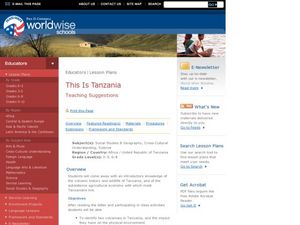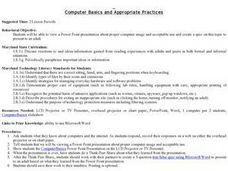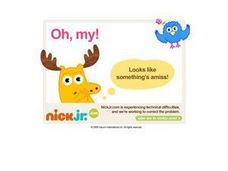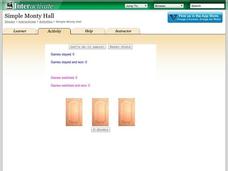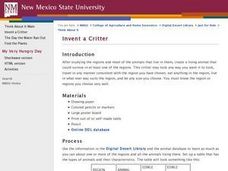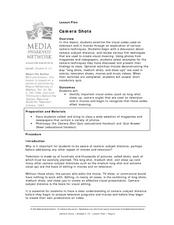Curated OER
This Is Tanzania
Young scholars explore Tanzania. In this geography skills activity, students read This is Tanzania by Richard Lupinsky, Jr. and discuss the impact that volcanoes have had on the nation. Young scholars analyze the imagery in Lupinsky's...
Curated OER
M&M Graphing
Fourth graders name colors of M&Ms and record answers. They estimate number of M&Ms of each color found in a typical package of M&Ms on piece of paper.They record information on sheet of paper and create a spreadsheet. paper.
Curated OER
Computer Basics and Appropriate Use
View this PowerPoint and go over the basic rules about computers. It is well-suited for all ages because the rules apply to all learners. Everyone benefits from knowing the terms for working with computers. But more importantly, make...
Curated OER
Math Sleuths
Help learners practice their math skills by utilizing the Internet to research a mathematical topic. Your math sleuths will investigate a science or social studies topic from their curriculum and construct a Math Hunt Grid. They create a...
Curated OER
Islamic Faith and Discrimination
After the events on 9/11 many Muslim-Americans experienced discrimination because of their ethnicity and faith. Help break the cycle of ignorance by educating your students on the history, religion, and beliefs of a different culture....
Curated OER
Dealing with Peer Influence: What Are Bullying and Harassment? Lesson 1 of 2
Fifth graders review definitions of bullying and harassment, respond to real-life bullying scenario from news, television, or movie, brainstorm possible solutions and consequences for negative behavior, and discuss how their peers...
IRISS
Exploring Self-Esteem 1: What Is Self-Esteem?
Adolescents explore self-esteem and the various factors that influence a person's sense of self in this four-part lesson series. Through a combination of whole class instruction, small group discussions, and independent work,...
Shodor Education Foundation
Simple Monty Hall
What's behind door number one? A fun resource lets learners simulate the classic Monty Hall probability problem. Pupils choose a door, and after they select a losing door, they decide whether to switch or stay. Using their decisions, the...
US Institute of Peace
Organizations Working for Peace
We're all in this together! Show young scholars that peace is a process and having the support of like-minded people can make it happen. 13th in a series of 15 peace building activities, groups conduct research on a peace organization,...
Curated OER
Creating Bar Graphs and Pie Graphs
Second graders observe a demonstration of the creation of a bar graph and a pie graph of their favorite colors. They gather information about various topics from their classmates, then organize the information, creating a bar and a pie...
Curated OER
An Interview With the Past: Ancient Roman and U.S. Government Leaders
Young scholars produce a modern television interview show where they present information about Ancient Rome and its influence on modern governments. In this governments lesson plan, students produce shows in groups.
Curated OER
Invent a Critter
Students create a living animal that could survive in at least one specific region and use the digital desert library to gather information. In this invent a critter instructional activity, students draw a picture of their animal, ...
Curated OER
The Diary of Anne Frank-Clash of the Clans
Middle schoolers read selected passages from The Diary of Anne Frank. They, in groups, discuss the television / movie characters and create character webs involving these characters and those in the Anne Frank book.
Curated OER
Back to the Past
What was the Untied States like in 1938? What were the concerns of Americans in the post World War I era? What were their fears? What were their sources of news and entertainment? To understand the reaction to Orson Welles' radio...
Curated OER
Linguistic Humor and Language Play
By George, there are so many literary devices illustrated here! Help your pupils create interest in their writing by presenting one or two of these literary devices at a time. The slides contain examples and beg participation from the...
Curated OER
Ride 'Em Cowboy (Buffalo Bill Cody and the Wild West Show)
Students research the impact of Buffalo Bill Cody and his Wild West Show on the world's view of American western culture. They create a poster advertising the Wild West Show.
Curated OER
The Pocahontas Show
Eleventh graders complete background reading of Europeans and the Native American Indians. They work in groups and represent an area of European colonization and create a "character" to represent their colonists on a class talk show....
Curated OER
Child Labor Slide Show
Students review ideas shared about the American worker while reading poems of Carl Sandburg. They now view a slide show of what they looked like. While students view the slide show, the teacher goes over information. A link is provided...
Curated OER
Show Your Colors and Make Freedom Bracelets
Learners understand the meaning of a freedom bracelet. In this terrorism lesson, students create freedom bracelets as a statement against terrorism. Learners weave this creative project in red, white and blue to show support of their...
Curated OER
Camera Shots
Understanding how visual codes such as long-shots, close-ups, and camera angles affect meaning helps prepare young filmmakers to plan their own productions. The concepts embedded could also be used to analyze photographs and paintings.
Curated OER
It's Raining Cats and Dogs! Literary Devices and Figurative Language
Third and fourth graders study literary devices and figurative language. They view a PowerPoint presentation (which you must create) to review hyperbole, idiom, simile, and metaphor. They read and discuss the book There's A Frog in...
Curated OER
Heart Collage
Explore the visual arts by creating a construction paper art project. In this collage lesson plan, young artists research the Internet to examine styles of famous artists including Keith Haring. They create cut-outs of hearts using...
Curated OER
A Picture's Worth 1000 Words: Decoding Intercultural Symbols
Learners interpret a set of pictographs, defining what each image means and create their own set of symbols as an alphabet. They then write using their own symbolic alphabet using pictures.
